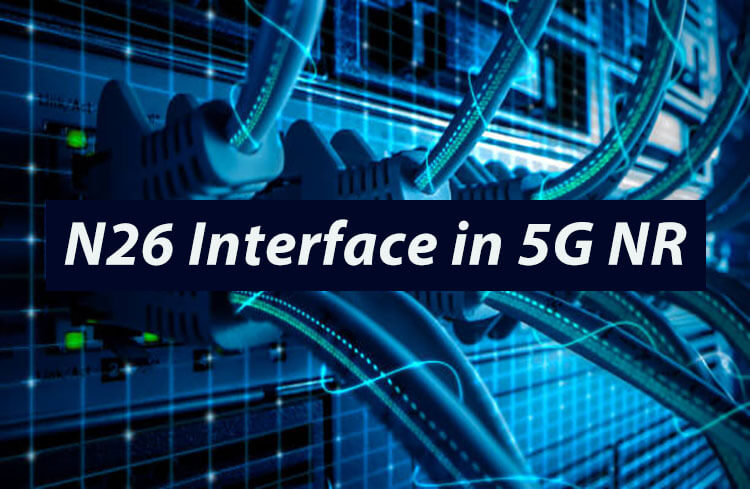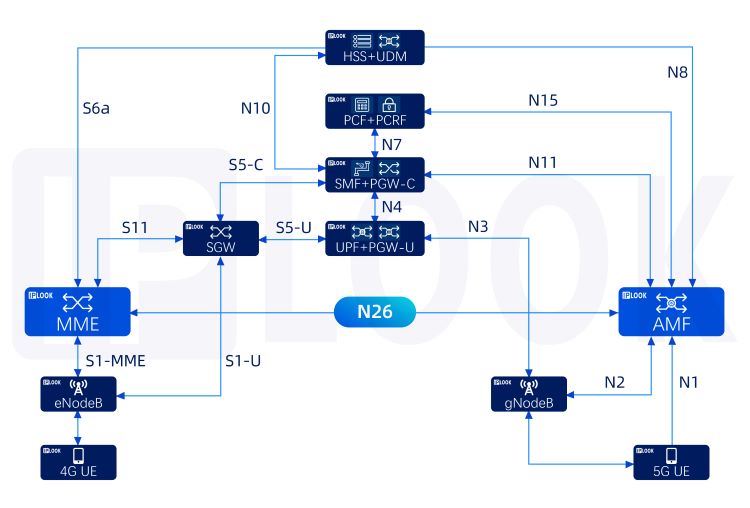N26 interface is an inter-Core Network interface between the MME and 5GS AMF in order to enable interworking between EPC and the NG core. Inter-RAT Mobility procedures involving mobility between LTE-EPC and 5G-NR-5GS utilize the N26 interface which enables the exchange of Mobility Management(MM) and Session Management (SM) states between the source and target RAT network.
N26 interface support is critical to enable seamless continuity for voice services during inter-RAT handover between LTE and 5G. For example, if a Voice call is initiated in NR i.e VONR call can be continued when there is an Inter-RAT handover to LTE and the voice call be continued as a VoLTE Call.
 Support of the N26 interface in the network is optional for interworking and not mandatory, However, when N26 support is available in the network it reduces latency during Inter-RAT procedures. N26 supports a subset of the functionalities (essential for interworking) that are supported over S10.
Support of the N26 interface in the network is optional for interworking and not mandatory, However, when N26 support is available in the network it reduces latency during Inter-RAT procedures. N26 supports a subset of the functionalities (essential for interworking) that are supported over S10.
· Networks that support interworking with EPC, may support interworking procedures that use the N26 interface or interworking procedures that do not use the N26 interface.
· Interworking procedures with N26 support provides IP address continuity on inter-system mobility to UEs that support 5GC NAS and EPC NAS and that operate in single registration mode.
· Networks that support interworking procedures without N26 shall support procedures to provide IP address continuity on inter-system mobility to UEs operating in both single-registration mode and dual-registration mode.
· In such networks, AMF shall provide the indication that interworking without N26 is supported to UEs during initial Registration in 5GC or MME may optionally provide the indication that interworking without N26 is supported in the Attach procedure in EPC as defined in TS 23.401 [26].
One another factor that comes into play is that UE Subscription in the core network should not have any restrictions towards Core Network Type (5GC) and RAT restriction for NR when UE is camped on EPC. The HSS provides these restrictions to the MME. The MME then provides the Core network type and RAT restrictions to the eNB based on the information received from HSS. The MME and the eNB use these restrictions to make a decision whether mobility to 5GS or NR Connected to 5GS should be permitted.
 Mobility from LTE to NR with PDU Sessions with N26 interface.
When UE has multiple PDUs in LTE Connected state and the network decides to perform Mobility to 5GS when n26 interface is supported. When the Bearers are activated on LTE for each PDU session the corresponding 5G PDU session-id is also mapped to each EPS Bearer. During mobility, the MME selects the PGW+SMF for PDN Connections that can be relocated to the target 5GS.
Mobility from LTE to NR with PDU Sessions with N26 interface.
When UE has multiple PDUs in LTE Connected state and the network decides to perform Mobility to 5GS when n26 interface is supported. When the Bearers are activated on LTE for each PDU session the corresponding 5G PDU session-id is also mapped to each EPS Bearer. During mobility, the MME selects the PGW+SMF for PDN Connections that can be relocated to the target 5GS.
PGW+ SMF determines which PDN Connections can be relocated to the target 5GS, e.g. based on the capability of the deployed 5GS, subscription and operator policies for which PDN Connection, seamless session continuity should be supported, etc. After success Mobility from LTE to NR, the 5GS indicates to UE in PDU Session which corresponding EPS bearers have been moved successfully to 5GS.
If the network supports the N26 interface and the UE has indicated for Support of S1 and N1 mode then the network configures the UE to receive QoS rule(s) of the 5GS QoS flow(s), which corresponds to the dedicated/default EPS bearer being activated, in the protocol configuration options IE or the extended protocol configuration options IE of the ACTIVATE DEDICATED EPS BEARER CONTEXT REQUEST or ACTIVATE DEFAULT EPS BEARER CONTEXT REQUEST message, the UE stores the QoS rule(s) for use during the inter-system change from the S1 mode to N1 mode.
In the case if Multiple PDU Sessions are moved from LTE and some PDU sessions cannot be moved or if there is no support for it on 5GS then the
The P-GW+SMF and NG-RAN can reject the PDN Connections that cannot be transferred as part of the handover or Idle mode mobility.
For example, if UE has two active PDU Sessions for Internet Bearer and another one for IMS bearer and during mobility, if the MME has chosen a P-GW for the internet PDN for which session continuity is not supported and the AMF cannot retrieve the address of the corresponding SMF during EPS to 5GS mobility, the AMF does not move the PDN connection to 5GS. After the Mobility, the UE has to trigger a new PDU session for internet PDN in the 5GS.
How does the network indicate Support for N26 Mode in LTE-RAT?
If the UE indicates support for N1 mode in the ATTACH REQUEST message and the MME supports inter-system interworking with 5GS, the MME may set the IWK N26 bit to either:
– “interworking without N26 not supported” if the MME does not support interworking procedures without N26 interface; or
– “interworking without N26 supported” if the MME supports interworking procedures without N26 interface in the EPS network feature support IE in the ATTACH ACCEPT message.
EPS network feature support information element
Interworking without N26 interface indicator (IWK N26) (octet 4, bit 7)
This bit indicates whether the network supports interworking procedure without N26 interface.
Bit
7
0 ---> Interworking without N26 not supported
1 ---> Interworking without N26 supported
How does the network indicate Support for N26 Mode in 5G?
If the UE included S1 mode supported indication in the REGISTRATION REQUEST message, the AMF supporting
interworking with EPS shall set the IWK N26 bit to either:
a) “interworking without N26 interface not supported” if the AMF supports N26 interface; or
b) “interworking without N26 interface supported” if the AMF does not support the N26 interface
in the 5GS network feature support, IE in the REGISTRATION ACCEPT message.
The UE supporting S1 mode operates in the mode for interworking with EPS as follows:
if the IWK N26 bit in the 5GS network feature support IE is set to “interworking without N26 interface not supported”, then the UE should operate in single-registration mode;
– if the IWK N26 bit in the 5GS network feature support IE is set to “interworking without N26 interface supported” and if the UE supports dual-registration mode, then the UE may operate in dual-registration mode; or
– if the IWK N26 bit in the 5GS network feature support IE is set to “interworking without N26 interface supported” and the UE only supports single-registration mode, then the UE should operate in single-registration mode.
The UE Can operate in either Single Registration mode or Dual registration mode and this feature is not controlled by the network and is independent of UE implementation. The support of a single registration mode is mandatory for UEs that support both 5GC and EPC NAS.
5GS network feature support information element
Interworking without N26 interface indicator (IWK N26) (octet 3, bit 7)
This bit indicates whether interworking without N26 interface is supported
Bit
7
0 ---> Interworking without N26 interface not supported
1 ---> Interworking without N26 interface supported
What is Single Registration Mode?
In Single Registration mode, UE has only one active MM state either in EPC or in 5GC.
UE has only one active MM state either RM state in 5GC or EMM state in EPC and it is either in 5GC NAS mode or in EPC NAS mode when connected to 5GC or EPC. In this mode, UE keeps a single coordinated registration for 5GC and EPC.
– During the Mobility from EPS to 5GC, the UE maps the EPS-GUTI to 5G GUTI and
– During the Mobility from 5GC to EPC, the UE maps the 5G GUTI to EPS-GUTI
When UE moves from 5GC to EPC it keeps the native 5G-GUTI and the native 5G Security Context. It Re-uses these in the case when UE comes back to 5GC from EPS.
In this mode, the UE may be registered to either 5GC or EPC only, it cannot be registered to both 5GC and EPC.
What is Dual Registration mode?
In dual-registration mode, UE handles independent registrations for 5GC and EPC using separate RRC connections. UE maintains 5G-GUTI for 5GC and EPS-GUTI for EPS independently.
In this mode, UE provides native 5G-GUTI, if previously allocated by 5GC, for registrations towards 5GC and it provides native EPSGUTI if previously allocated by EPC, for Attach/TAU towards EPC.
In this mode, the UE may be registered to 5GC only, EPC only, or to both 5GC and EPC
MME supports the following Interworking procedures with the N26 interface:
· Attach procedure
· EPS to 5GS Mobility Registration procedure
· 5GS to EPS Idle mode mobility procedure
· 5GS to EPS Handover
· EPS to 5GS Handover
· 5GS to EPS Handover Cancel
· EPS to 5GS Handover Cancel
Source: https://wirelessbrew.com/5g-nr/n26-interface-between-lte-and-5gnr/ 


